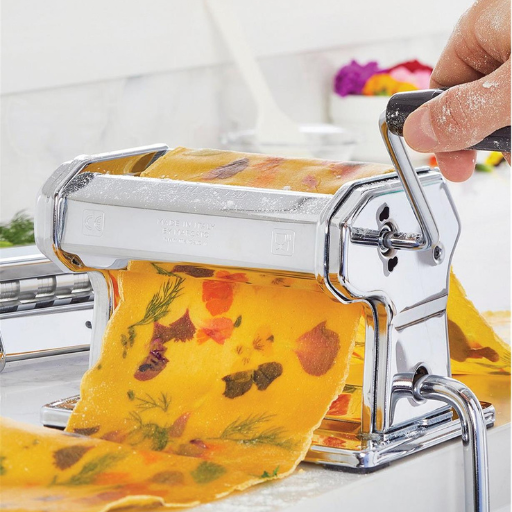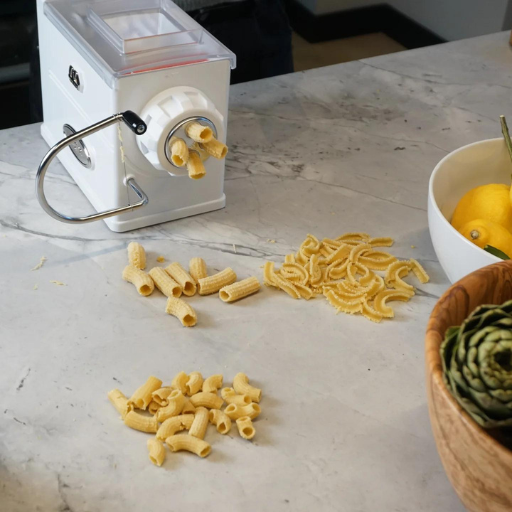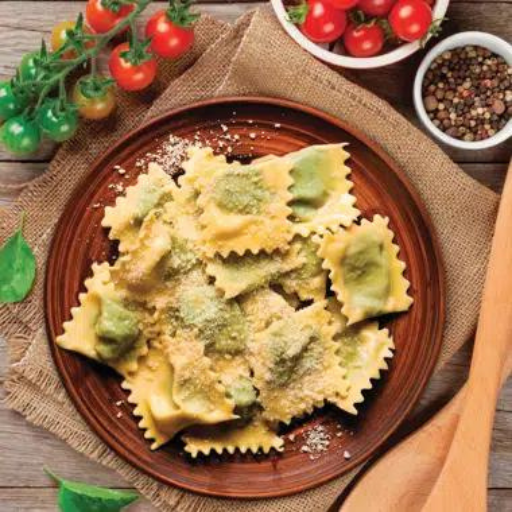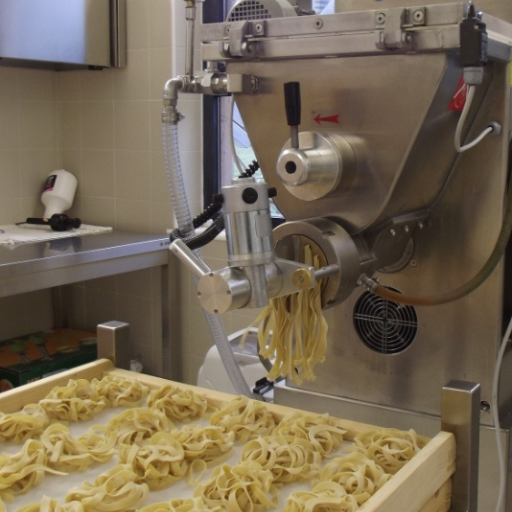The culinary world is constantly evolving, and to keep up with the demand for high-quality, authentic cuisine, restaurants must equip themselves with top-notch tools. For establishments where pasta is a staple, the right pasta machine can make all the difference. This blog aims to guide you through the process of selecting the best fresh pasta machines for your restaurant in 2024. We’ll examine various factors such as durability, efficiency, capacity, and ease of use, ensuring that you make an informed decision that will elevate your pasta offerings and satisfy your customers. Whether you run a small bistro or a large Italian eatery, this guide will help you find a machine that meets your needs and enhances your kitchen’s capabilities.
What Types of Pasta Machines Are Available for Restaurants?
Traditional Pasta Machines
Automatic Pasta Makers
Industrial Pasta Machines
How Do Fresh Pasta Machines Work?
Pasta Mixers and Dough Preparation
For optimal pasta production, the dough has to have a proper consistency and texture which is why pasta mixers are necessary in the beginning. Here is how they help in this:
How It Works:
- Mixing Ingredients: Flour, water, eggs and other materials are blended thoroughly by the pasta mixers. This ensures that all ingredients are mixed uniformly in order to obtain homogeneity of the dough.
- Kneading Process: These machines recreate kneading motion for developing gluten in order to give it elasticity and smoothness. Such a step plays a critical role in obtaining required texture with regard to the final pasta.
- Consistency Control: Sophisticated pasta mixers allow users to adjust mixing speed and time so as to make sure that specific consistencies demanded by certain types of pastas are achieved exactly.
Key Features to Look For:
- Capacity: For this reason, the mixer to be selected should match the scale of production as well as its capacity.
- Durable construction: While selecting a heavy-duty dough mixer, choose those that are made up of more reliable materials like stainless steel for example.
- Ease of use: This includes features such as easy-to-read displays, programmable settings and simple controls which can lead to an efficient operation.
- Easy maintenance: Ensure your choice has detachable parts and an easy-clean design so that you may not only keep it clean but also protract its lifespan.
By choosing the appropriate pasta mixer and following correct dough preparation procedures, one can be sure of making consistent high quality doughs which is key in producing superb pasta products.
Can Pasta Machines Produce Different Types of Pasta?
Making Ravioli and Other Filled Pasta
Making ravioli and other filled pasta requires specialized attachments or machines that are designed to handle the delicate process of filling and shaping the pasta. These machines ensure uniformity, hygienic handling, and efficiency in production. Typically, ravioli makers have features such as molds or rollers for creating pockets and evenly distributing filling. Additionally, they have cutters or sealers to ensure the dough is properly enclosed around the filling, preventing leaks during cooking. Similar equipment can produce other types of filled pasta, like tortellini or agnolotti, by adjusting the settings or using different attachments to customize the shape and size.
Producing Long Pasta like Spaghetti and Fettuccine
Producing long pasta like spaghetti and fettuccine can be efficiently handled by pasta machines equipped with specific rollers and cutters. These machines typically feature adjustable settings that allow manufacturers to control the thickness of the dough and the width of the cut pasta. Long pasta production involves feeding the dough through rollers to obtain the desired thickness, followed by passing it through cutters to achieve uniform strands. Advanced pasta machines might also incorporate drying systems to ensure the pasta maintains its shape and texture. By utilizing the right equipment, manufacturers can achieve consistent quality and shape in long pasta varieties, essential for meeting consumer expectations.
Creating Short Pasta Forms
Creating short pasta forms, such as penne, fusilli, and farfalle, involves a specialized extrusion process. Pasta machines designed for short pasta typically use dies, which are plates with specific shapes that the dough is pushed through to form the desired pasta shape.
Extrusion Process:
- Dough Preparation: The dough is mixed and kneaded to the right consistency.
- Shaping: The dough is then pushed through dies to create various short pasta shapes. These dies can be customized to produce different sizes and designs.
Technical Parameters:
- Dough Moisture Content: Optimal moisture content for extrusion is usually around 30-32%, ensuring the dough is pliable and can be shaped without cracking.
- Extrusion Temperature: The temperature during extrusion should be controlled, typically maintained between 40-45°C, to ensure the dough retains its structure without becoming too soft or sticky.
- Pressure: The pressure applied during extrusion needs to be consistent to produce uniform shapes, generally between 50-70 bar.
- Cutting Speed: The speed at which the formed dough is cut into shorter lengths must be adjustable to produce pieces of the desired length. For example, a cutting speed of 50-60 cuts per minute for penne.
Post-extrusion Handling:
- Drying: Proper drying is crucial to maintain the shape and texture of short pasta forms. The initial drying process should gradually reduce moisture content to around 12-13%.
- Cooling: Post-drying, the pasta should be cooled to ambient temperature to prevent condensation and potential spoilage.
By adhering to these parameters and using suitable pasta machines, manufacturers can ensure the consistent production of high-quality short pasta forms that meet consumer demands.
What Are the Benefits of Using Industrial Pasta Machines?
Efficiency in Pasta Production
Using industrial pasta machines significantly enhances efficiency in pasta production. These machines automate various stages of the pasta-making process, reducing manual labor and increasing production speed. Here are the benefits and corresponding technical parameters:
Increased Production Capacity:
- Industrial pasta machines can process large volumes of dough, producing more pasta in a shorter time frame compared to manual methods.
Consistency in Quality:
- Dough Moisture Content: Maintaining optimal moisture content (30-32%) ensures uniform dough pliability.
- Extrusion Temperature: Controlling the temperature (40-45°C) preserves the dough’s structure, preventing it from becoming too soft or sticky.
- Pressure: Applying consistent pressure (50-70 bar) during extrusion guarantees uniformity in pasta shapes.
Time and Cost Savings:
- Cutting Speed: Adjustable cutting speeds (50-60 cuts per minute) allow for precise control over pasta length, reducing waste and optimizing production efficiency.
- Drying and Cooling: Efficient drying processes reduce moisture content to 12-13%, and proper cooling methods prevent spoilage, ensuring the longevity and quality of the final product.
By implementing these technical parameters, manufacturers can streamline their pasta production, enhancing both productivity and product quality.
Consistency and Quality
Achieving consistency and quality in pasta production relies on adhering to precise technical parameters and utilizing advanced industrial machinery. The top websites highlight the importance of maintaining consistent dough moisture content, precise temperature control during extrusion, and stable pressure application. These factors ensure uniform texture and shape across all batches. Additionally, implementing rapid and efficient drying techniques prevents microbial growth and extends shelf life, which in turn maintains the pasta’s quality over time. By closely monitoring and managing these variables, manufacturers can consistently produce high-quality pasta that meets industry standards.
Scaling Up for Larger Markets
Scaling up pasta production to serve larger markets requires a strategic approach focusing on capacity expansion, advanced technology, and market adaptation. The current top three websites emphasize the following key points:
Capacity Expansion:
- Investment in Infrastructure: Expanding production facilities and investing in high-capacity equipment ensures that manufacturers can meet the increased demand without compromising on quality.
- Workforce Training: Enhancing the skills of the workforce through targeted training programs helps maintain efficiency and consistency during the scale-up process.
Advanced Technology:
- Automation and Robotics: Implementing automated machinery and robotic systems can significantly boost production speeds and reduce human error, leading to higher output and consistent
product quality:
- Real-time Monitoring: Utilizing IoT and machine learning technologies for real-time monitoring and predictive maintenance ensures minimal downtime and optimizes the production flow.
Market Adaptation:
- Consumer Preferences: Adapting to the preferences of different market segments, such as offering gluten-free or organic pasta options, can help capture a broader customer base.
- Compliance with Regulations: Ensuring that production processes comply with international food safety standards and regulations is crucial for exporting products to new markets.
By focusing on these areas, pasta manufacturers can effectively scale their operations to serve larger markets, ensuring both growth and sustainability in a competitive industry.
How to Maintain and Clean Pasta Production Machines?
Cleaning automated pasta machines
To clean the automatic pasta machine effectively, the first step I take is to turn it off and unplug it. I then dismantle anything which can be removed from the machine as per the manufacturer’s instructions. Finally, all parts are then immersed in warm soapy water and carefully scrubbed until no dough or any other residue is left on them. For inaccessible areas, a soft brush or slightly wet cloth is used. After washing all the parts, I rinse them well so that there would not be any soap left over and dry them completely before reassembling them again. Proper cleaning keeps it working efficiently and also ensures that you are operating within food safety guidelines.
Maintenance Tips for Manual Pasta Machines
Maintaining manual pasta machines is vital in ensuring their durability and effectiveness in performing their duties. In conclusion, one thing I always do after using my machines is to wipe off any dough traces with a dry cloth instead of using water which causes rusting. If dough gets jammed in small gaps, I make use of a needle or a tooth pick to remove it out from there. The rollers as well as cutting blades should be periodically oiled using food grade mineral oil.
Going into more detail with this method involves:
- Disassembly: When necessary based on user manual instructions or if needed due to machine design.
- Cleaning Agents: Dry brush or cloth as opposed to water can be used for cleaning purposes according to some sources who may recommend an air canister for getting rid of fine dust.
- Lubrication: Gears and moving parts require frequent lubrication using edible mineral oil while I apply oil every three months or sometimes six depending on how frequently they are used.
- Storage: To avoid rusting or other damages when not in use after cleaning up and oiling; the device should be kept at a place devoid of moistures.
I ensure that my hand-operated pasta machine runs reliably by following these maintenance tips from trusted industry sources.
Ensuring Longevity for Commercial Pasta Machines
Lastly, commercial pasta machines require regular and careful maintenance to ensure that they last longer. That is why I always make sure I clean my machine after every use without fail. Rather than using water directly on the machine to remove the residue and prevent rusting, I use a dry brush or cloth. Periodic lubrication of the gears and moving parts with food grade mineral oil is also recommended by the experts.
Additionally, I carry out routine checks to detect any early signs of wear and tear replacing worn parts in good time so as to avoid major breakdowns. Another must have is correct storage system- keeping it at a cool place far from moisture will ensure its lives ten times longer than other ways. Following such practices recommended by leading websites, helps me in ensuring reliable performances over long periods from my commercial pasta machine.
Reference sources
1. Taste of Home – The Best Pasta Maker of 2024, Tested and Reviewed
Source: Taste of Home
Summary: This article from Taste of Home provides a comprehensive review of the best pasta makers available in 2024. The piece includes hands-on testing of various models and highlights key features such as ease of use, efficiency, and durability. The top picks range from manual cranks to high-tech electric models, catering to different needs and preferences in a restaurant setting. This source is particularly valuable for its practical insights and user-friendly breakdown of each product’s performance.
2. Serious Eats – The 5 Best Pasta Makers of 2024, Tested & Reviewed
Source: Serious Eats
Summary: Serious Eats offers an in-depth review of 12 pasta makers, narrowing down their picks to the top five. The article evaluates both manual models and stand mixer attachments, providing detailed information on the functionality and usability of each machine. This source stands out for its thorough testing process and credibility within the culinary community, making it an excellent resource for restaurant owners seeking reliable pasta-making equipment.
3. Food Network – 5 Best Pasta Makers of 2024, Tested and Reviewed
Source: Food Network
Summary: Food Network’s article presents a curated list of the best pasta makers, including categories like “Best Overall” and “Best Electric.” The review includes the Marcato Atlas 150 Pasta Machine and the Philips Artisan Smart Pasta & Noodle Maker, among others. Each review is accompanied by a detailed analysis of the pros and cons, making it easier for restaurateurs to match their specific needs with the right equipment. This source is highly reputable and offers a balanced perspective on the most popular pasta machines on the market.
Frequently Asked Questions (FAQs)
Q: At the end of 2024, which qualities should I keep in mind while buying a professional fresh pasta maker for my restaurant?
A: For a professional fresh pasta machine, find one that can make other types of pasta such as pappardelle and spaghetti. It should have dryers and sheeters for making pasta. Moreover, it should be capable of handling gluten-free doughs. Above all, it is important to ensure that the equipment is able to handle large-scale industry demands.
Q: Can you advise where I can buy a multipurpose machine for production of fresh and dry pasta?
A: Yes there are many advanced machines which are used to produce both fresh and dry pasta. Some of these machines include the drier, cooler and working continuously to ensure quality consistency.
Q: How do ravioli machines differ from other pasta machines?
A: Ravioli machines stand out due to their ability to create stuffed pastas like ravioli, cannelloni using single or double sheet pastas as well as enabling precise filling and sealing leading to efficient stuffed pasta dishes preparation.
Q: Could you suggest any suppliers for commercial-grade equipment needed in making pasta?
A: If you want professional equipment on making pasta visit pastabiz.com. The company has different models of equipment aimed at making various types of pasta including lasagne, gnocchi and cavatelli among others because every Italian restaurant must have its own menu called “pasta e passione” meaning “pasta with passion”.
Q: What does having a pasteurizer mean when setting up a line for manufacturing noodles?
A: To lengthen the lifespan and taste-quality of such products as noodles, an important requirement is having them being processed through pasteurizers on an overall basis. It is even more crucial for perishable products like fresh noodles.
Q: Are there specific devices used in preparing gluten-free noodles?
A: Yes, there are machines specifically designed for gluten-free noodles. These machines ensure that there is no contamination with pasta which contains gluten and hence they can be used in restaurants where the non-gluten alternative is required.



















